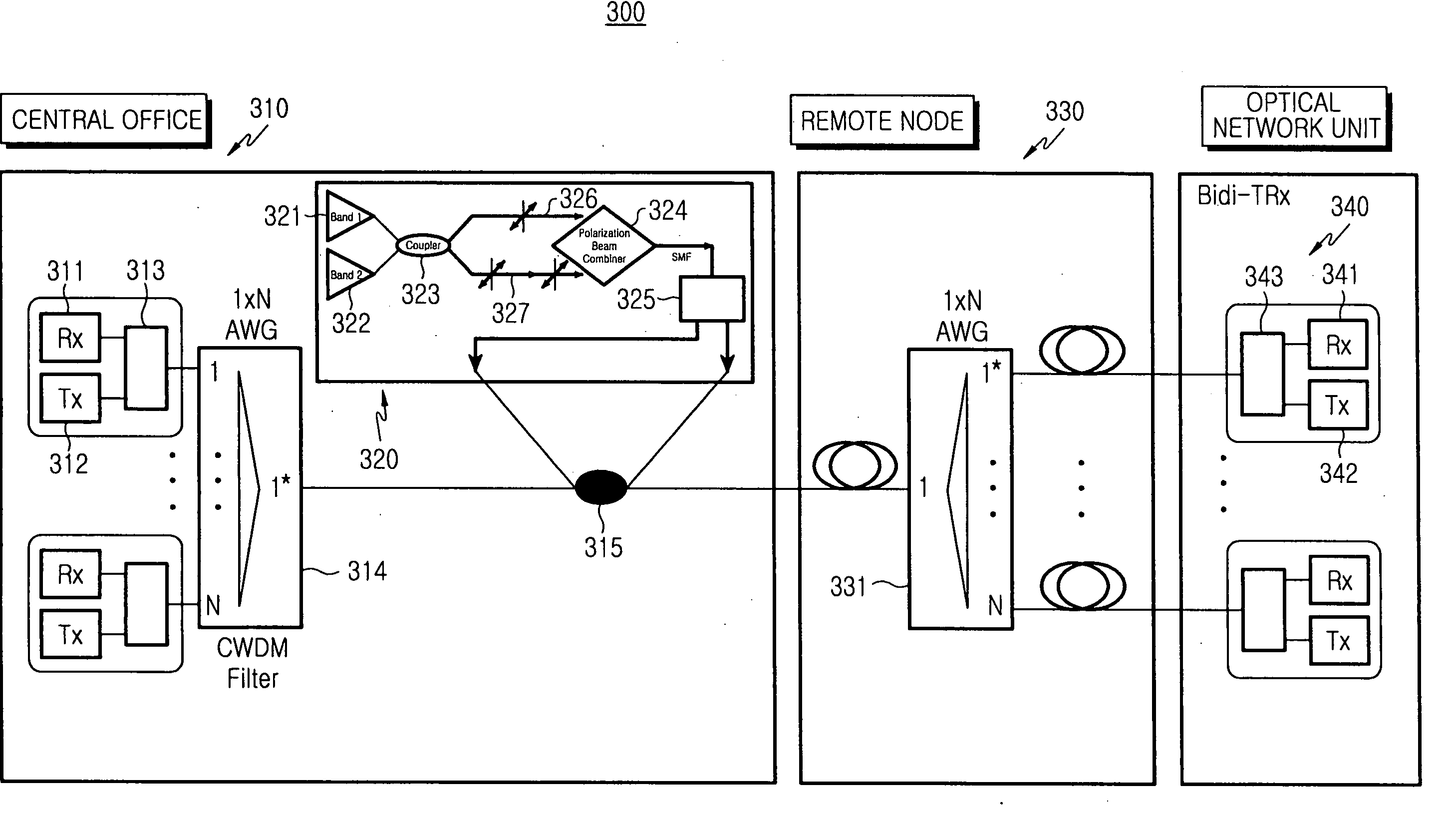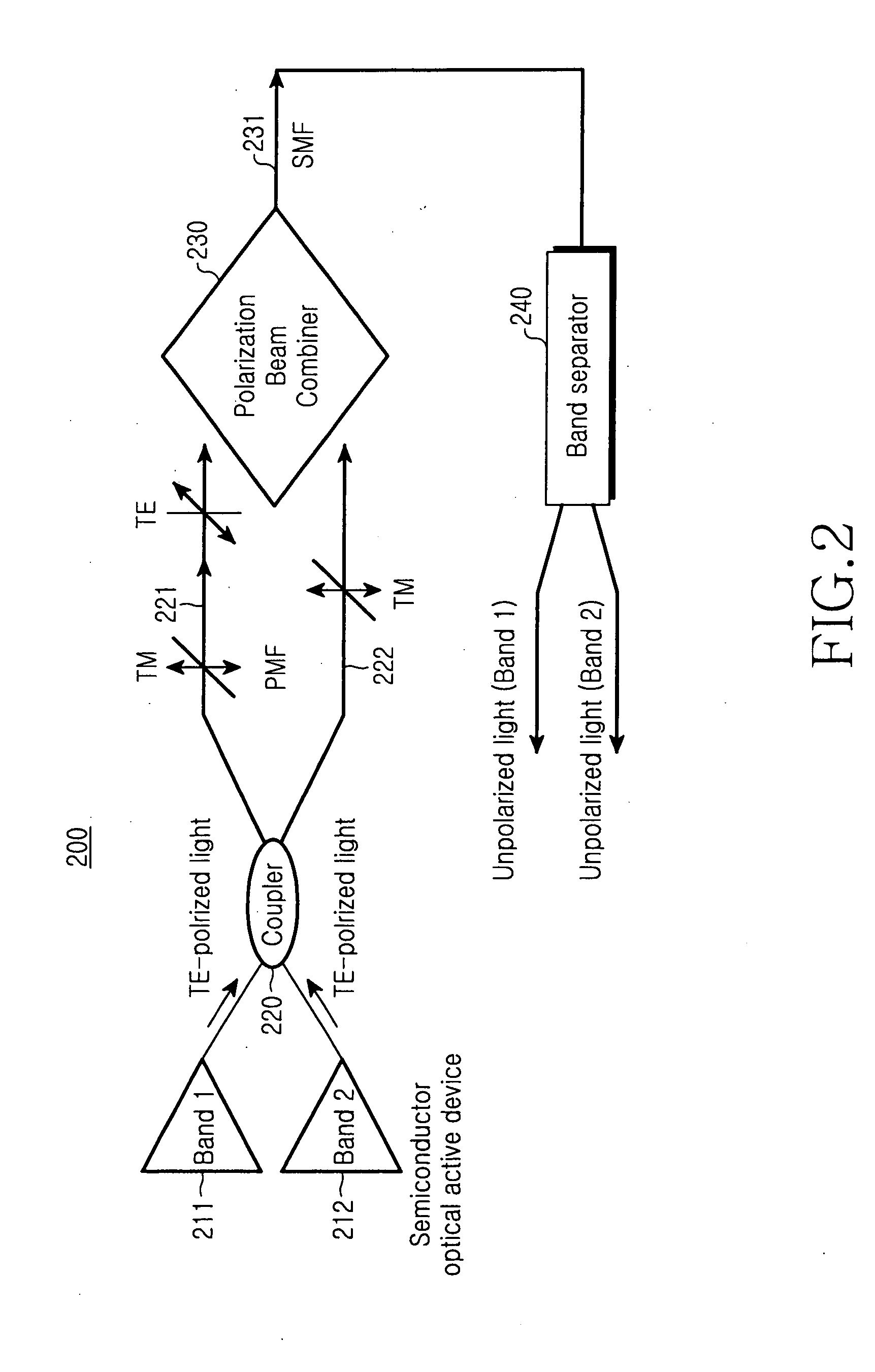Wavelength-division-multiplexed passive optical network
a passive optical network and wavelength division technology, applied in the field of active-type semiconductor optical devices, can solve the problems of limited wavelength of erbium-doped optical fiber amplifiers, high fabrication costs and large volume, and largely limited in the selection of wavelength bands and ranges. , to achieve the effect of removing the polarization dependence of ligh
- Summary
- Abstract
- Description
- Claims
- Application Information
AI Technical Summary
Benefits of technology
Problems solved by technology
Method used
Image
Examples
first embodiment
[0015]FIG. 1 is a block diagram illustrating the configuration of a broadband light source according to the present invention.
[0016] As shown, the broadband light source 100 includes two or more semiconductor optical active devices 111 and 112, an optical coupler 120, first and second optical lines 121 and 122, a polarization beam combiner 130, a band separator 140, and a single-mode optical fiber 131. The single-mode optical fiber 131 is located between the polarization beam combiner 130 and the band separator 140 and transmits a polarization-independent light to the band separator 140.
[0017] The semiconductor optical active devices 111 and 112 may include a superluminescent diode (SLD), a semiconductor optical amplifier (SOA), or other equivalent optical device capble of generating a light of a specific polarization mode. The semiconductor optical active devices 111 and 112 generate TE polarized lights having wavelength bands different from each other.
[0018] The optical coupler ...
second embodiment
[0022]FIG. 2 is a block diagram illustrating the configuration of a broadband light source according to the present invention.
[0023] As shown, the broadband light source 200 includes two or more semiconductor optical active devices 211 and 212, an optical coupler 220, first and second optical lines 221 and 222, a polarization beam combiner 230, a band separator 240, and a single-mode optical fiber 231. The single-mode optical fiber 231 is located between the polarization beam combiner 230 and the band separator 240, and transmits a polarization-independent light to the band separator 240.
[0024] The semiconductor optical active devices 211 and 212 generate TM polarized lights having wavelength bands different from each other and output the generated TM polarized lights to the optical coupler 220. The optical coupler 220 divides each of the TM polarized lights into two TM polarized lights, then outputs the two divided TM polarized lights (including a first TM polarized light and a se...
third embodiment
[0027]FIG. 3 is a block diagram illustrating a passive optical network including a broadband light source according to the present invention. The passive optical network 300 includes a central office 310, a plurality of optical network units 340, and a remote node 330 located between the central office 310 and the optical network units 340. The central office 310 generates wavelength-locked downstream optical signals and also detects upstream optical signals, and each of the optical network units 340 receives a downstream optical signal of a relevant wavelength. The remote node 330 and the central office 310 are linked by a main optical fiber, and each of the optical network units 340 is linked to the remote node 330 by a local optical fiber.
[0028] The central office 310 includes a broadband light source 320, a plurality of downstream light sources 312, a plurality of upstream optical detectors 311, a plurality of wavelength selection combiners 313, a multiplexer / demultiplexer 314, ...
PUM
 Login to View More
Login to View More Abstract
Description
Claims
Application Information
 Login to View More
Login to View More - R&D
- Intellectual Property
- Life Sciences
- Materials
- Tech Scout
- Unparalleled Data Quality
- Higher Quality Content
- 60% Fewer Hallucinations
Browse by: Latest US Patents, China's latest patents, Technical Efficacy Thesaurus, Application Domain, Technology Topic, Popular Technical Reports.
© 2025 PatSnap. All rights reserved.Legal|Privacy policy|Modern Slavery Act Transparency Statement|Sitemap|About US| Contact US: help@patsnap.com



